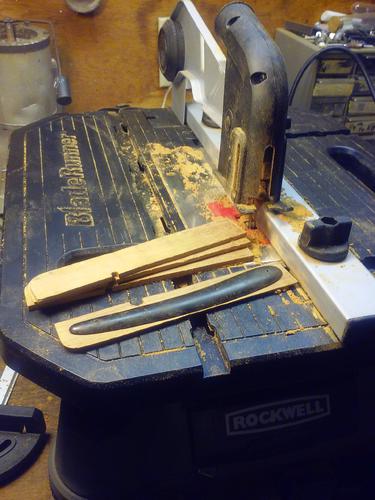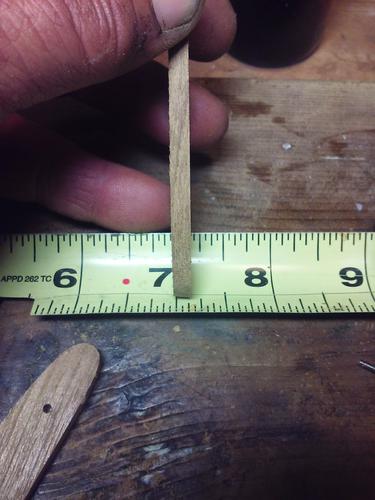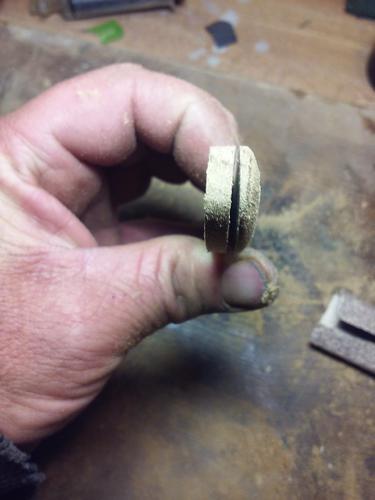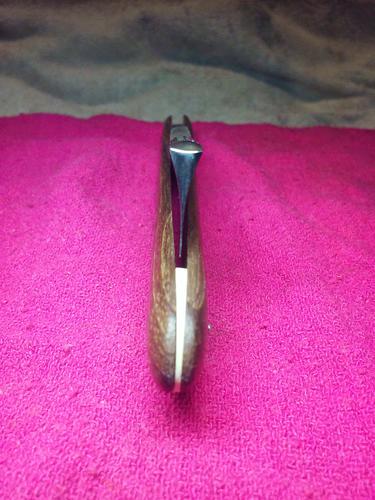Results 1 to 10 of 14
Hybrid View
-
06-27-2015, 11:59 PM #1Senior Member



- Join Date
- Feb 2015
- Location
- Duluth, GA - Atlanta OTP North
- Posts
- 2,546
- Blog Entries
- 1
Thanked: 315 Trouble Flattening Inside of Scales At Wedge End
Trouble Flattening Inside of Scales At Wedge End
I'm making some curly maple scales and I've almost finished shaping them. One problem I'm having though is that when you put the two scales together, there is 'V' at the wedge end. I guess this happened when I was sanding off the paper/glue from when I first cut the scales. I know this will cause a gap between the thin end of the wedge and the scales, so I need to straighten it out. I've tried sanding it a couple different ways, but it doesn't seem to helping too much.
Any advice on how to get rid of the 'V' gap so the scales fit better? Thanks
-
06-28-2015, 12:04 AM #2Senior Member


- Join Date
- Jun 2013
- Location
- Pompano Beach, FL
- Posts
- 4,048
Thanked: 636
You need to be sure you are on a flat surface. Sand paper on flat surface with material to be sanded. With evev pressure sand the scales. If you still have a tiny gap at wedge fill it with super glue.
-
06-28-2015, 12:19 AM #3

Also, a slightly concave surface scraped into the inside of the wedge ends allows them to seal around the wedge. That way the edges of the scales are pulled tight to the edge. Or, you can concave the sides of the wedge a tiny bit...if...the scales are dead flat. No more than a piece of paper deep. And... open the top and bottom of the drilled hole in the wedge. That allows the pin to assume any angle necessary to fit up the scales.
~RichardBe yourself; everyone else is already taken.
- Oscar Wilde
-
-
06-28-2015, 01:00 AM #4Senior Member



- Join Date
- Feb 2015
- Location
- Duluth, GA - Atlanta OTP North
- Posts
- 2,546
- Blog Entries
- 1
Thanked: 315
Yeah, I have the sandpaper on a flat surface. I know that is a must. I need to rig some sort of large sanding block I could attach the scale to, so the pressure is distributed evenly.
Geezer, if flattening doesn't work I'll probably try the concave surface idea. Can you give me something as a reference so I know how concaved your talking about?
-
06-28-2015, 02:22 AM #5

no more than a piece of paper depth , this is done a lot with wood working . most call it a back cut like on mitres only in this case , causing a small dish in the middle of the joining of the scales and wedge so that the outer edges make contact before the insides
“ I,m getting the impression that everyone thinks I have TIME to fix their bikes”
-
The Following User Says Thank You to tcrideshd For This Useful Post:
outback (06-28-2015)
-
06-28-2015, 11:19 AM #6Senior Member



- Join Date
- Feb 2015
- Location
- Duluth, GA - Atlanta OTP North
- Posts
- 2,546
- Blog Entries
- 1
Thanked: 315
I misworded my follow up question. What I was wondering was how steep the convex of the sanding medium should be. I thought maybe he used something specific to convex the sandpaper when he was sanding.
Last edited by JP5; 06-28-2015 at 02:09 PM.
-
06-28-2015, 01:43 PM #7

This has been a very informative post.
Though I've never encountered this problem YET.
The saw and blade that i use makes very clean cuts, so I've never had to sand the inside of the scales EVER. i just make the wedge a little bigger than the scales and then shape the wedge to the scales.



YMMVMike
-
06-28-2015, 02:01 PM #8Senior Member



- Join Date
- Apr 2012
- Location
- Diamond Bar, CA
- Posts
- 6,553
Thanked: 3215
Geezer touched on it but, remember to chamfer the pin holes on both sides of the wedge and on the inside of the scales with a larger drill bit or countersink.
Any burrs from drilling can keep the wedge from fitting together tightly.
Or use a lead wedge.
You can make a scraper for one time use with an inexpensive putty knife, grinder, files and sand paper, it is not as hard as a cabinet scraper, but it will hold an edge long enough to do a pair of scales.Last edited by Euclid440; 06-28-2015 at 02:06 PM.
-
The Following User Says Thank You to Euclid440 For This Useful Post:
outback (06-28-2015)
-
06-28-2015, 02:20 PM #9Senior Member



- Join Date
- Apr 2012
- Location
- Diamond Bar, CA
- Posts
- 6,553
Thanked: 3215
When you glue your scales together, as said make sure the insides are flat first, then use white glue or rubber cement with a piece of paper between them.
It does not have to be a crazy strong bond, there will be no force trying to separate the joint, just enough to hold them together. So you can shape them.
You can glue a block of wood to the outside of your scales with rubber cement to have something to hold on to and lap the insides flat on a sheet of fine sandpaper.
-
06-28-2015, 11:07 PM #10Senior Member



- Join Date
- Feb 2015
- Location
- Duluth, GA - Atlanta OTP North
- Posts
- 2,546
- Blog Entries
- 1
Thanked: 315
Thank for the scraper suggestion. That seems like it would work better since you have more control of where the material is being removed and the amount.
Well, the wood scales I'm working on don't have a wedge yet. I can see the gap when I put the two scales together so I know they aren't perfectly flat.
I used the paper and glue before cutting and shaping the scales. That is why I mentioned sanding off paper/glue from the inside of the scales in the first post. Not a big deal though.
I believe my first mistake was not using even pressure when sanding off the glue/paper from the inside of the scales. I've thinking I should have done something like you mentioned at the end with a block. I may try that next time. ThanksLast edited by JP5; 06-28-2015 at 11:11 PM.


 7Likes
7Likes LinkBack URL
LinkBack URL About LinkBacks
About LinkBacks






 Reply With Quote
Reply With Quote

